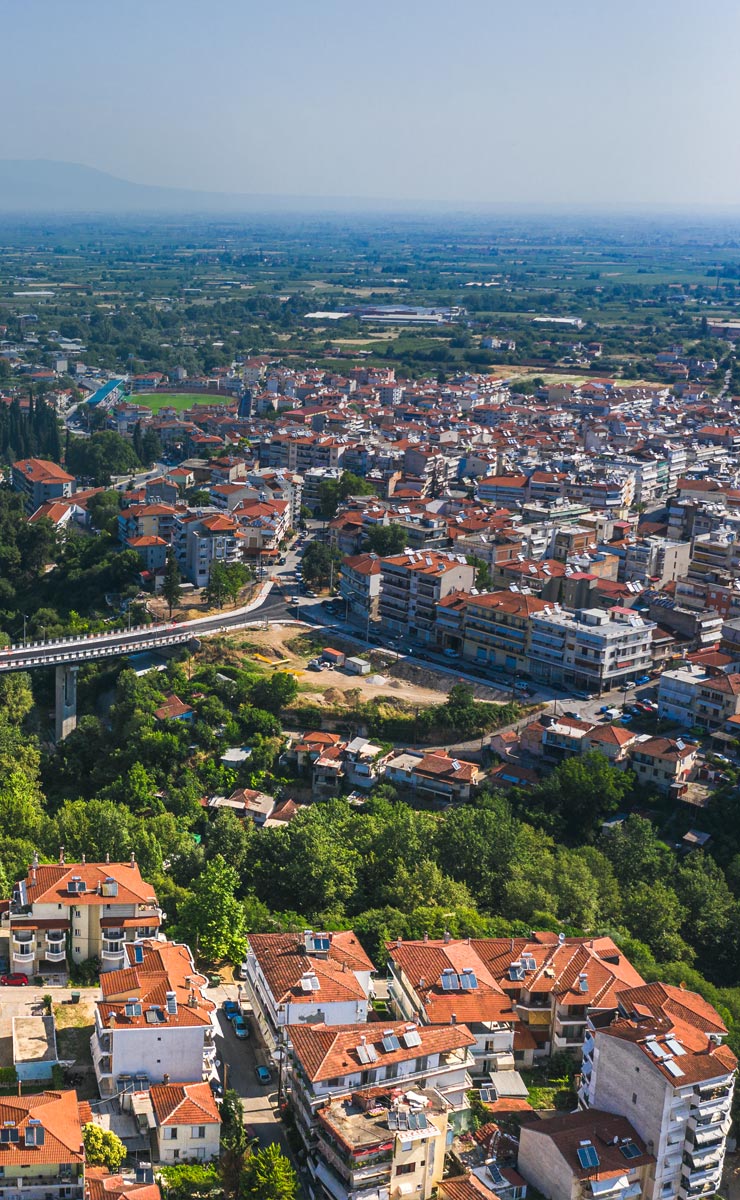Veria: City On a Cliff
There is evidence that the site of Veria has been occupied by humans as early as 1000 BC. It's easy to see why: the city, 37 miles (60 km) west and south of Salonika, sits on a ridge on the foothills of the Vermio Mountains. It overlooks, to the east, the Macedonian Plain, which was the heart of the Macedonian Empire. It is an impressively beautiful view. Which also would have given the ancient city ample warning if invaders were coming out of the 180-degree panorama from the east. Veria's main square and park, Elia Park, "the balcony of Veria," is built on the edge of the ridge, with the flatness of the plain stretching out for a long distance towards the east. For a time Veria was Macedonia's second city, after Pella, the capital, which was down there in the lowlands to the east.
There had been a Romaniote Jewish presence in Veria for centuries when the Apostle Paul came through in the early 50's AD, fleeing the persecution he had encountered in Salonika. He had preached and established a church in Salonika, which had aroused the wrath of the local Jews. The New Testament reports that he found in the Verian Jews a "more noble" character, because they diligently searched their scriptures to see if Paul's proclamation of the Messiah was accurate. At that time Veria, and Greece, was occupied by the Romans.
There followed a series of occupying powers, including the Bulgars, the Franks and the Serbs. In between those occupations, some of them brief, Veria was part of the Byzantine empire. During this time it was a center of Greek learning, and many churches were built, in addition to several Byzantine-era monuments which are still standing. The Ottoman Turks came in 1433 and stayed until 1912. They built a number of mosques, 5 of which still survive, in various states of disrepair.
On the plain, about 5 miles (7 km) east of Veria, is the archeological site of Aigai, or Vergina, which was the first capital of the Kingdom of Macedonia. It is a UNESCO World Heritage Site. Its location, long suspected to be in the area, was finally discovered in the 1860's, after excavations of tumuli burial mounds began. Its necropolis contains over 300 tumuli, some of which date back to the early Iron age (1100-700 BC). During the archaic period (800-500 BC), it was the site of the royal court of Macedon.
In about 400 BC, the Macedonian administrative center was moved to Pella, 22 miles (35 km) northeast of Vergina (and about the same distance west of Salonika). But Vergina retained its position as the sacred city of the kingdom, where religious rites were observed, until Dion supplanted it as a religious center, and its kings were buried there.
It was in Vergina, in October of 336 BC, that King Philip II was assassinated by one of his own body guards while entering the Royal Theatre during a marriage celebration, and the crown passed to Alexander, his son, soon to earn the sobriquet "the Great." A large tumulus was excavated in the 1970's, and the claim, disputed by some, is that the grave of Philip II, the father of Alexander the Great, was uncovered. Finds from the tomb, including beautiful gold work, are house in the Archeological Museum of Salonika, as well as the local museum in Vergina.
The old Jewish Quarter of Veria, in the Historical center of the city known as Barbouta, was turned into a ghost town by the German Occupation, but has now been largely restored. In fact, it is one of the best-preserved Jewish Quarters in Europe. It is a triangular-shaped walled compound with a central courtyard, and two gates for ingress and egress. Virtually all of Veria's Jews, numbering about 500, were shipped off to the death camps by the Nazis, and the quarter fell into disrepair. The buildings are of timber and stone construction, using locally grown chestnut beams between courses of local limestone. The Quarter is next to the old Byzantine walls, just beyond which is the Tripotamos River, which splits the city in two. The synagogue, abandoned for decades, has been recently remodeled and upgraded.
Because Veria is a small city, it is best explored on foot. The old Christian Quarter, with its stone-paved, narrow streets, stone houses, built, as in the Jewish quarter, with local stone and timber, features walled-off gardens protected by heavy, metal, nail-studded doors which provided security for its residents. Houses in both Quarters feature, as well, sahnisia, the upper story projecting outward over the street and supported by timbers.
In the Historical Center, there are Turkish baths, mosques, and minarets cheek by jowl with Byzantine-era churches. Next to the City Hall, the massive, flat stones of a portion of the ancient main roadway has been exposed.
Veria features a small archeological museum, and a Byzantine museum.












